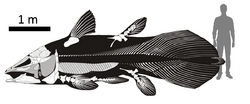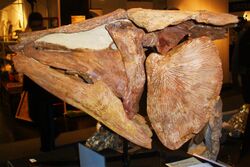Biology:Mawsonia (fish)
| Mawsonia | |
|---|---|

| |
| Skeleton of Mawsonia gigas, showing estimated size of largest known individual | |
| Scientific classification | |
| Domain: | Eukaryota |
| Kingdom: | Animalia |
| Phylum: | Chordata |
| Clade: | Sarcopterygii |
| Class: | Actinistia |
| Order: | Coelacanthiformes |
| Family: | †Mawsoniidae |
| Genus: | †Mawsonia Woodward, 1907 |
| Species | |
| |
Mawsonia is an extinct genus of prehistoric coelacanth fish. It is amongst the largest of all coelacanths, with one quadrate specimen (DGM 1.048-P) possibly belonging to an individual measuring 5.3 metres (17.4 feet) in length.[2] It lived in freshwater and brackish environments from the late Jurassic to the mid-Cretaceous (Tithonian to Cenomanian stages, about 152 to 96 million years ago) of South America, eastern North America, and Africa. Mawsonia was first described by British paleontologist Arthur Smith Woodward in 1907.[3]
Description
The fish has six fins: two on the top of the body, two on the sides, one at the end of its tail and one at the bottom of its tail. Rather than having teeth, the inside of the mouth was covered in small (1-2 mm) denticles.[4] It reached at least 3.5 m (11 ft) in length, although one specimen possibly exceeded 5 m (16 ft), only rivaled by the related Trachymetopon.[5][6][2]
Taxonomy
The genus was named by Arthur Smith Woodward in 1907, from specimens found in the Early Cretaceous (Hauterivian) aged Ilhas Group of Bahia, Brazil.
Fossils have been found on three continents; in South America they have been found in the Bahia Group, Romualdo, Alcântara, Brejo Santo and Missão Velha Formations of Brazil , and the Tacuarembó Formation of Uruguay.[4] In Africa, they are known from the Continental Intercalaire of Algeria and Tunisia, the Ain el Guettar Formation of Tunisia, the Kem Kem Group of Morocco, and the Babouri Figuil Basin of Cameroon, spanning from the Late Jurassic, to early Late Cretaceous. Fossils assigned to Mawsonia have also been found in Woodbine Formation of Texas , United States , then part of the island continent Appalachia.[7][8]
The type species is Mawsonia gigas, named and described in 1907. Numerous distinct species have been described since then. M. brasiliensis, M. libyca, M. minor, and M. ubangiensis have all been proposed to be synonyms of M. gigas,[6][9] although Léo Fragoso's 2014 thesis on mawsoniids[10] finds M. brasiliensis valid and cautions against synonymizing M. minor without further examination. Several recent publications consider M. brasiliensis to be valid as well.[9][11][12][13] Although initially considered to belong to this genus, "Mawsonia" lavocati is most likely referable to Axelrodichthys instead.[13][14]
Ecology
Mawsonia was native to freshwater and brackish ecosystems.[15] The diet of Mawsonia and their mechanism of feeding is uncertain. It has been suggested that the denticles were used to crush hard shelled organisms (durophagy)[16] or that prey was swallowed whole using suction feeding.[17]
References
- ↑ Sereno, P. C.; Dutheil, D. B.; Iarochene, M.; Larsson HCE; Lyon, G. H.; Magwene, P. M.; Sidor, C. A.; Varricchio, D. J. et al. (1996). "Predatory Dinosaurs from the Sahara and Late Cretaceous Faunal Differentiation". Science 272 (5264): 986–91. doi:10.1126/science.272.5264.986. PMID 8662584. Bibcode: 1996Sci...272..986S. http://doc.rero.ch/record/13893/files/PAL_E831.pdf.
- ↑ 2.0 2.1 Cavin, Lionel; Piuz, André; Ferrante, Christophe; Guinot, Guillaume (2021-06-03). "Giant Mesozoic coelacanths (Osteichthyes, Actinistia) reveal high body size disparity decoupled from taxic diversity" (in en). Scientific Reports 11 (1): 11812. doi:10.1038/s41598-021-90962-5. ISSN 2045-2322. PMID 34083600. Bibcode: 2021NatSR..1111812C.
- ↑ Mawsonia at Fossilworks.org
- ↑ 4.0 4.1 Toriño, Pablo; Soto, Matías; Perea, Daniel; Salgado de Carvalho, Marise Sardenberg (1 April 2021). "New findings of the coelacanth Mawsonia Woodward (Actinistia, Latimerioidei) from the Late Jurassic – Early Cretaceous of Uruguay: Novel anatomical and taxonomic considerations and an emended diagnosis for the genus" (in en). Journal of South American Earth Sciences 107: 103054. doi:10.1016/j.jsames.2020.103054. ISSN 0895-9811. Bibcode: 2021JSAES.10703054T. https://www.sciencedirect.com/science/article/pii/S0895981120305976.
- ↑ Dutel, Hugo; Pennetier, Elisabeth; Pennetier, Gérard (2014-07-29). "A giant marine coelacanth from the Jurassic of Normandy, France". Journal of Vertebrate Paleontology 34 (5): 1239–1242. doi:10.1080/02724634.2014.838176. ISSN 0272-4634. Bibcode: 2014JVPal..34.1239D. https://doi.org/10.1080/02724634.2014.838176.
- ↑ 6.0 6.1 de Carvalho, Marise S. S.; Maisey, John G. (2008). "New occurrence of Mawsonia (Sarcopterygii: Actinistia) from the Early Cretaceous of the Sanfranciscana Basin, Minas Gerais, southeastern Brazil". Geological Society, London, Special Publications 295 (1): 109–144. doi:10.1144/sp295.8. ISSN 0305-8719. Bibcode: 2008GSLSP.295..109D. https://doi.org/10.1144/SP295.8.
- ↑ Cavin L, Toriño P, Van Vranken N, Carter B, Polcyn MJ, Winkler D (2021) The first late cretaceous mawsoniid coelacanth (Sarcopterygii: Actinistia) from North America: Evidence of a lineage of extinct ‘living fossils’. PLoS ONE 16(11): e0259292. https://doi.org/10.1371/journal.pone.0259292
- ↑ "Visiting instructor part of fossil fish team". 21 December 2021. https://www.times-news.com/west_virginia/visiting-instructor-part-of-fossil-fish-team/article_0a60ab4c-6275-11ec-bb61-07dbc671e0df.html.
- ↑ 9.0 9.1 Cupello, Camila; Batista, Thatiany A.; Fragoso, Léo G.; Brito, Paulo M. (2016-10-01). "Mawsoniid remains (Sarcopterygii: Actinistia) from the lacustrine Missão Velha Formation (Lower Cretaceous) of the Araripe Basin, North-East Brazil" (in en). Cretaceous Research 65: 10–16. doi:10.1016/j.cretres.2016.04.009. ISSN 0195-6671. Bibcode: 2016CrRes..65...10C. http://www.sciencedirect.com/science/article/pii/S0195667116300672.
- ↑ Fragoso, Léo (2014). "Revisão do Ramo Gondwânico da família Mawsoniidae (Sarcopterygii: Actinistia: Coelacanthiformes)". Doctoral Dissertation, Universidade do Estado do Rio de Janeiro. http://www.bdtd.uerj.br/tde_busca/arquivo.php?codArquivo=7375.
- ↑ Batista, Thatiany Alencar; Bantim, Renan Alfredo Machado; Lima, Flaviana Jorge de; Santos Filho, Edilson Bezerra dos; Saraiva, Antônio Álamo Feitosa (2019-11-01). "New data on the coelacanth fish-fauna (Mawsoniidae) from the Late Jurassic and Early Cretaceous of Araripe Basin, Brazil" (in en). Journal of South American Earth Sciences 95: 102280. doi:10.1016/j.jsames.2019.102280. ISSN 0895-9811. Bibcode: 2019JSAES..9502280B. http://www.sciencedirect.com/science/article/pii/S0895981119301816.
- ↑ Cavin, Lionel; Cupello, Camila; Yabumoto, Yoshitaka; Léo, Fragoso; Deersi, Uthumporn; Brito, Paul M. (2019). "Phylogeny and evolutionary history of mawsoniid coelacanths". Bulletin of the Kitakyushu Museum of Natural History and Human History, Series A 17: 3–13. http://www.kmnh.jp/wp-content/uploads/2019/05/A17-3-Cavin.pdf.
- ↑ 13.0 13.1 Fragoso, Léo Galvão Crainer; Brito, Paulo; Yabumoto, Yoshitaka (2019-11-26). "Axelrodichthys araripensis Maisey, 1986 revisited". Historical Biology 31 (10): 1350–1372. doi:10.1080/08912963.2018.1454443. ISSN 0891-2963. https://doi.org/10.1080/08912963.2018.1454443.
- ↑ Ibrahim, Nizar; Sereno, Paul C.; Varricchio, David J.; Martill, David M.; Dutheil, Didier B.; Unwin, David M.; Baidder, Lahssen; Larsson, Hans C. E. et al. (2020-04-21). "Geology and paleontology of the Upper Cretaceous Kem Kem Group of eastern Morocco". ZooKeys (928): 1–216. doi:10.3897/zookeys.928.47517. ISSN 1313-2970. PMID 32362741. PMC 7188693. https://zookeys.pensoft.net/article/47517/.
- ↑ Meunier, François J.; Cupello, Camila; Yabumoto, Yoshikata; Brito, Paulo M. (2018). The diet of the Early Cretaceous coelacanth †Axelrodichthys araripensis Maisey, 1986 (Actinistia: Mawsoniidae). doi:10.26028/CYBIUM/2018-421-011. http://sfi-cybium.fr/fr/diet-early-cretaceous-coelacanth-†axelrodichthys-araripensis-maisey-1986-actinistia-mawsoniidae.
- ↑ Barbara S. Grandstaff, Joshua Smith, Matthew Lamanna, Allison Tumarkin-Deratzian, Joshua B Smith, Matthew Lamanna, Allison Tumarkin-Deratzian (2004) Cranial Kinesis and Diet in Mawsonia (Actinistia, Coelanthiformes)
- ↑ Cavin, Lionel; Boudad, Larbi; Tong, Haiyan; Läng, Emilie; Tabouelle, Jérôme; Vullo, Romain (2015-05-27). "Taxonomic Composition and Trophic Structure of the Continental Bony Fish Assemblage from the Early Late Cretaceous of Southeastern Morocco" (in en). PLOS ONE 10 (5): e0125786. doi:10.1371/journal.pone.0125786. ISSN 1932-6203. PMID 26018561. Bibcode: 2015PLoSO..1025786C.
Further reading
- Fishes of the World by Joseph S. Nelson
- History of the Coelacanth Fishes by Peter Forey
- Discovering Fossil Fishes by John Maisey and John G. Maisey
- The Rise of Fishes: 500 Million Years of Evolution by John A. Long
- Evolution of Fossil Ecosystems by Paul Selden and John Nudds
Wikidata ☰ Q21355619 entry
 |


